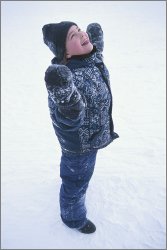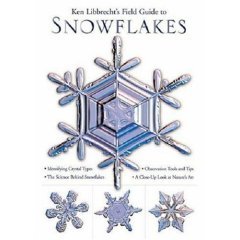Are No Two Snowflakes Really Alike?
(and Other Amazing Snowflake Facts & Pictures)
by www.SixWise.com
Snowflakes -- bouncing in a chilly wind, settling on the
tip of your tongue or flurrying outside an icy window -- are
one of the simple pleasures in life.
|

The mystery and simple beauty of snowflakes bring out
the kid in all of us.
|
But while simple in their beauty, the making of a snowflake,
and the intricacies they contain, are actually quite complex.
How Snowflakes are Formed
Contrary to popular belief, snowflakes are not formed when
raindrops freeze (this is called sleet). Snowflakes are formed
inside of clouds, when water droplets freeze and become ice
particles. Water vapor in the cloud gathers on the ice particle,
causing it to spread into a simple hexagonal prism and then
to sprout branches to form a more complex shape.
From here, though, snowflakes take on shapes of their own.
The environment inside of a cloud (the temperature and humidity)
is constantly changing, so much so that it changes the shape
of the snowflakes, sometimes from one second to the next.
"A crystal might begin to grow in one manner and then
minutes or even seconds later something changes (temperature
or humidity), so it starts to grow in another manner. The
hexagonal symmetry is maintained, but the ice crystal may
branch off in new directions ... In the end, there are
all kinds of forms that can arise: everything from prisms
and needles to the familiar lacy snowflakes," says Howard
T. Evans, Jr., an x-ray crystallographer and scientist emeritus
at the U.S. Geological Survey.
It's the ever-changing environment inside of clouds that
makes snowflakes unique. So is it true that no two snowflakes
are alike?
|
Ken Libbrecht's
Field Guide to Snowflakes

This beautiful pocket-sized book is packed with information
on how to find and identify the snowflakes in your own
backyard. In "Ken
Libbrecht's Field Guide to Snowflakes," you'll
learn about the science and art of snowflakes, and,
best of all, see remarkable photographs of real snowflakes
taken by Libbrecht.
|
"It is indeed extremely unlikely that two complex snowflakes
will look exactly alike. It's so extremely unlikely, in fact,
that even if you looked at every one ever made you would not
find any exact duplicates," says physicist Kenneth Libbrecht,
author of "Ken
Libbrecht's Field Guide to Snowflakes."
35 Types of Snowflakes
While each snowflake may be unique, Libbrecht says there
are 35 different types of snowflakes that you can recognize
if you look closely. Some of the more common to keep an eye
out for:
-
Stellar Plates: Thin, plate-like crystals with
six broad arms that form a star-like shape.
-
Stellar Dendrites: Plate-like snow crystals that
have tree-like branches and side-branches. This type of
snowflake is often used as the shape for holiday decorations.
-
Needles: Slender, columnar ice crystals that grow
when the temperature is around 23 degrees F. They appear
like tiny white hairs when they land on your clothing.
-
Rimed Crystals: Frozen water droplets in clouds,
called rime, sometimes collect on snowflakes. When the
coverage is heavy, the snowflakes can take on the appearance
of a tiny snowball.
-
Fern-Like Stellar Dendrites: Similar to stellar
dendrites, but with so many branches that they take on
a fern-like appearance. These snowflakes are the largest
ones out there, with diameters of 5 mm or more.
The Snowflake Man
|

An up-close view of a real snow crystal.

There are 35 common shapes of snowflakes (but each
one within the category is unique)
Source: www.snowcrystals.com
|
Wilson Bentley (1865-1931) was a farmer who did pioneering
work in photomicrography. In 1885, Bentley became the first
person to photograph a single snowflake, and went on to capture
over 5,000 snowflake images during his lifetime (without finding
two that were the same).
In 1931, Bentley, who became known as "the Snowflake
Man," published over 2,000 images in his unprecedented
book, "Snow
Crystals."
"Under the microscope, I found that snowflakes were
miracles of beauty; and it seemed a shame that this beauty
should not be seen and appreciated by others. Every crystal
was a masterpiece of design and no one design was ever repeated.
When a snowflake melted, that design was forever lost. Just
that much beauty was gone, without leaving any record behind,"
Bentley said of his work.
The Largest Snowflake Ever?
The largest snowflake ever recorded, according to the Guinness
World Records, was 15 inches wide and 8 inches thick. A man
named Matt Coleman observed the snowflake in 1887 at Fort
Keogh, Montana, and said the snowflake was "larger than
milk pans."
However, official measurements of snowflake dimensions are
not routinely taken, says the National Snow and Ice Data Center.
The title may still be up for grabs, so head outside next
time the snowflakes start falling and see what you can find!
Recommended Reading
How
to Winterize Your Car ... and Your Brain for Winter Driving
12
Tips to Lower Your Heating Bill This Winter
Sources
Snowcrystals.com
ScientificAmerican.com
M&C
Science & Nature
Wilson
Snowflake Bentley
USAToday.com